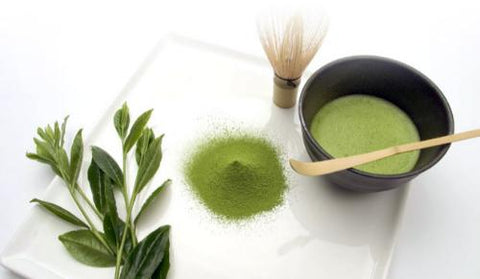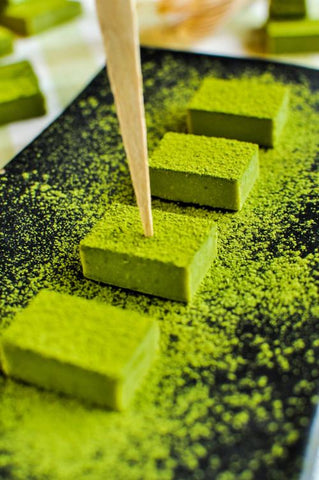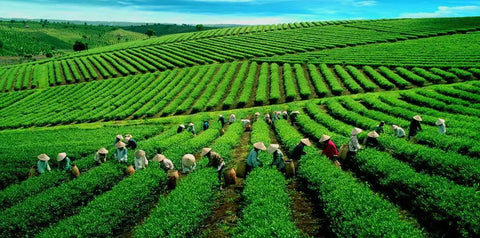Distinguishing matcha powder from green tea powder
Many people often confuse matcha powder and green tea powder when using. So do not miss the useful information that will guide you on how to distinguish matcha powder and green tea powder, as well as how to use it for drinks and the uses of each of these types.
-
What is matcha powder and green tea powder?
What is matcha powder? Source? Recognizing characteristics
What is matcha powder?
Matcha powder is a fine powder made from 100% young buds of the green tea plant and is produced by a special process: newly budded tea buds are shaded, harvested, steamed and dried by wind, remove the veins and grind into a fine powder.
Matcha powder has high nutritional value and is much more expensive than green tea powder. Matcha powder is derived from Chinese green tea powder, thanks to the missionary monks who brought this powder to Japan and increasingly focused on how to produce matcha powder as it is today.
The word "cha" in matcha means tea, and the word "ma" means powder, this was a very precious beverage of the nobility and monks in the early days. However, at present, matcha powder has been used more commonly with all walks of life.
Recognizing characteristics
You can identify matcha powder through some of the following characteristics:
- Color : bright green, even and very soft powder.
- Solubility : completely soluble in water.
- Taste : initially perceived bitterness at the tip of the tongue, then sweetness.
- Incense aroma: pleasant. In addition, some manufacturers can add seaweed ingredients to matcha powder, so the nutritional content is 7 times higher, and you can even smell a bit fishy when drinking.
What is green tea powder? Source? Recognizing characteristics
What is green tea powder?
Green tea powder is a powder that is ground from 70% young tea leaves and 30% tea buds, produced with a simpler process than matcha powder: picking the tea, not pulling the veins, drying and grinding by industrial machines.
Green tea powder has a lower nutrient content than matcha and is cheaper.
Green tea powder has been around for a long time and is known as a nutritious and healthy food in China. Although green tea powder is widely used in China, when it comes to green tea powder, many people immediately think of Japan - where the famous matcha powder is created.
Thanks to the founder of the Rinzai sect of Zen Buddhism, a Japanese monk named Eisai (1141-1215) brought green tea powder closer to other classes of people (besides aristocrats) and warriors Samurai. He has proven many benefits and uses of green tea for health.
Around the end of the 12th century, the art of making tea called "tencha" was born, and it was Eisai who introduced how to make tea from fine green tea powder to everyone. Upon returning to Japan from China, he fell under the tea seed and propagated throughout Japan.
Therefore, green tea powder, even premium matcha powder gradually appeared in religious ceremonies in Buddhist monasteries at that time.
Recognizing characteristics
You can identify green tea powder through some of the following identifications:
- Color : dark green, sometimes slightly yellowish, not smooth, and piggy.
- Solubility : not completely soluble in water.
- Taste : bitter acrid, less sweet aftertaste, not as thick as matcha powder because the veins are not removed.
- Incense fragrance : no sweet aroma concentration.
-
Difference in production process and characteristics

There is no small difference between matcha powder and green tea powder, in here will help you better understand these two powders through the following production process:
Production process
|
Matcha powder |
|
|
The tea tree grows naturally, but after the young shoots emerge gradually (around early May), the whole plant is covered with industrial plastic nets at least 3 weeks before the start of harvesting. |
The tea tree grows naturally in the sun. |
|
Thanks to shading with a net before the harvest time, it helps tea leaves to regulate photosynthesis, increase chlorophyll, minerals, and nutrients. The tea sprouts are harvested manually (by hand) called Gyokuro tea. After collecting the tea buds, they are dried by the wind, removing the leaf veins and petioles, the flesh (called Tencha) and finely ground with a granite mortar, to produce matcha powder. |
Collecting tea leaves and tea buds, drying and grinding by industrial machines to produce green tea powder. |
|
Because it is air-dried and covered before harvesting, the chlorophyll in the tea leaves is not lost and more is produced. At the same time, because it is ground with a stone mortar, matcha powder is not affected by heat generation, making the color of the green powder more natural and smoother. |
Because of the heat drying, the chlorophyll in the tea leaves is lost. At the same time, when being ground by an industrial machine, it is still affected by heat generation, so the tea powder may be yellow, or black, and the powder is not smooth. |
|
High nutrient content. |
Low nutritional content. |
|
Expensive price. |
The price is cheap, only 1/3 of the price of matcha powder. |
Characteristics between matcha powder and green tea powder
|
Matcha powder |
Green tea powder |
|
Super smooth, soft and light. |
Seeds are slightly large, coarse (due to the absence of veins and petioles) and appear to be heavier. |
|
Melts in the tongue, at first there is a bitter taste but then a sweet, fresh and cool taste. |
Melt but still smooth, bitter taste, no sweet aftertaste when drinking. |
|
The scent is fresh, mild, even a bit fishy like seaweed (due to retaining minerals, especially iron in tea leaves). Or some manufacturers have added seaweed powder to increase the nutrients for matcha powder and help the color stay fresher. |
The flavor is not equal to matcha and the nutrient content is 7 times less than that of matcha powder. |
|
The price is expensive, ranging from $58 - $250 per kg. |
Cheap price, ranging from $30 - $38 per kg. |
-
How to use matcha powder and green tea powder

Once you know how to distinguish and understand the manufacturing process of the two powders: matcha and green tea, you can choose to use the powder depending on your needs, preferences and even your pocket.
However, some suggests on how to use these two powders as follows:
- Because matcha powder has a beautiful color, natural sweetness and bitterness, good solubility, it is often used in cooking: making cakes, making ice cream, making drinks, ....
- Because green tea powder has high antiseptic properties besides many good uses (similar to matcha) but has a low price, it is often used for skin care more.
-
Health benefits of matcha powder and green tea powder
Uses of matcha powder
- Providing more antioxidants help cells avoid destruction of free radicals that cause cancer mail.
- Contains high amounts of catechins, such as epigallocatechin gallate (EGCG) that have anti-inflammatory properties, maintain blood vessel integrity, and improve cell damage.
- Rich in protein, fiber, vitamins A, C and iron, it is able to fight viruses, bacteria and fungi, avoid staph infections, hepatitis B and genital fungi.
- Contains many amino acids such as L-theanine, increases alpha waves in the brain, improves memory, mood, soothe, town police and focused, more alert.
- Improves diabetes, reduces blood sugar and triglyceride levels, positively affects good cholesterol levels in the body.
- Reduce damage and disease related to kidney and liver.
- Effective weight loss support when increasing total calories burned by increasing metabolic rate, while increasing the efficiency of selective body fat burning by 17%.
Uses of green tea powder
- Increases elasticity, reduces inflammation, improves pigmentation and skin health, as well as aids in the healing of scars (redness) on the skin, sunburn, age spots, and also protects the skin from the onset of rays. UV from the sun.
- Thanks to the antioxidants, green tea powder has the effect of curing eye swelling when it shrinks the blood vessels in the sensitive eye area. Besides, the amount of vitamin K in green tea also helps reduce dark circles under the eyes.
- Reduce the aging process and prevent cancer. A skin thanks to antioxidants in green tea powder has the ability to neutralize free radicals (harmful).
- Regulate and rebalance the hormone levels in the body to prevent acne and effectively fight bacteria.
- Helps to grow strong, thick hair as well as prevent hair loss thanks to a lot of panthenol, vitamins C and E in green tea powder.
- Makes skin smoother and firmer with the ability to shrink pores.
Follow us on social with hashtag #therikeinc #matchapowder







Leave a comment